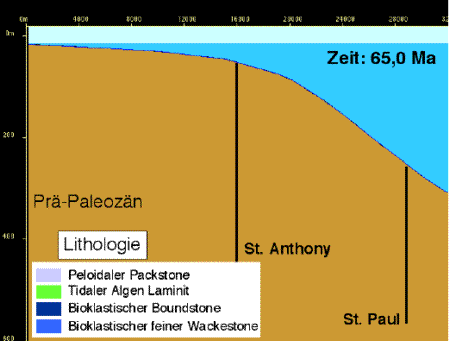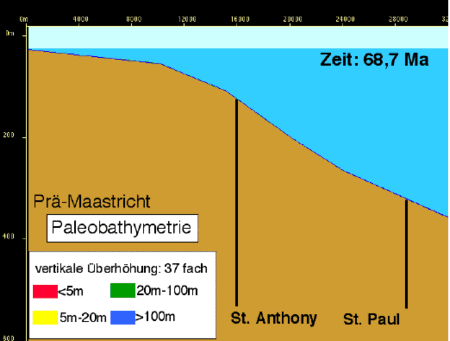Architecture of carbonate platforms in Egypt
Christian Scheibner
DFG-Graduierten Kolleg Stoff-Flüsse in marinen Geosystemen
Simulation of Paleocene deposition on the Galala-Wadi
Araba high (Egypt).
Platform-to-basin transitions are key areas for understanding
processes that involve both the platform and the adjacent basin. Only
here the progradation or retrogradation of the platform can be dated precisely
with calcareous nannofossils or planktic foraminifers that live in deep
waters and shallow benthic organisms from the platform. This temporal
accuracy is necessary to discuss and correlate climatic and environmental
processes on the platform with those in the adjacent basin. Furthermore,
platform-to-basin settings provide essential information on the type of
platform. Until now, the reasons for changes between different platform
morphologies are only poorly understood. Possible reasons for morphologic
transitions are the lack of framebuilding organisms, large extinctions
of the dominating organisms, oceanic (upwelling and eutrophication), climatic,
and tectonic factors (Burchette and Wright, 1992). With respect to these
fundamental geological aspects the Upper Cretaceous to Lower Paleogene
successions of the Galala Mountains in the Eastern Desert of Egyt are
of special interest.
Simulation run (with PHIL)
Paleocene stage
In this simulation the chosen parameter is the lithology. The first part
is characterised by small fluctuations of sea level, low subsidence rates
and low carbonate input resulting into very low sedimentation. The second
part starting from 59,25 Ma is characterised by high sea-level fluctuations,
resulting in alternating sedimentation and erosion.

Maastrichian stage
In this simulation the chosen parameter is the paleobathymetry. In the
first part of the simulation aggradation dominates, due to high subsidence
and sea-level rise. In the second part the sea-level falls and the sequences
are prograding (66,9 Ma). The third part of the simulation is again characterised
by rising sea level, resulting first in an aggradation followed by retrogradation
after a more rapid sea-level rise (66.0 Ma). The last part is characterised
by progradation due to a stable sea level and low subsidence-rates (65.5
Ma).



